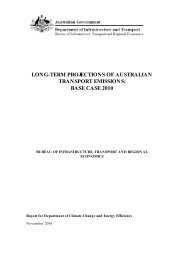Implications of Climate Change for Australia's World Heritage ...
Implications of Climate Change for Australia's World Heritage ...
Implications of Climate Change for Australia's World Heritage ...
Create successful ePaper yourself
Turn your PDF publications into a flip-book with our unique Google optimized e-Paper software.
IMPLICATIONS OF CLIMATE CHANGE FOR AUSTRALIA’S WORLD HERITAGE PROPERTIES: A PRELIMINARY ASSESSMENT<br />
3.2 Potential impacts on cultural heritage values<br />
3.2.1 Potential impacts on properties listed as meeting any/all cultural heritage listing<br />
criteria (iii) to (vi)<br />
Australian <strong>World</strong> <strong>Heritage</strong> properties that meet any/all criteria (iii) to (vi) (Box 3) include:<br />
• Kakadu National Park<br />
• Willandra Lakes Region<br />
• Tasmanian Wilderness<br />
• Uluru-Kata Tjuta National Park.<br />
Box 3. Cultural heritage listing criteria (iii) to (vi)<br />
Criterion (iii): To bear a unique or at least exceptional testimony to a cultural tradition or to a civilization which is living or<br />
which has disappeared.<br />
Criterion (iv): To be an outstanding example <strong>of</strong> a type <strong>of</strong> building, architectural or technological ensemble or landscape<br />
which illustrates (a) significant stage(s) in human history.<br />
Criterion (v): To be an outstanding example <strong>of</strong> a traditional human settlement, land-use, or sea-use which is representative<br />
<strong>of</strong> a culture (or cultures), or human interaction with the environment especially when it has become vulnerable under the<br />
impact <strong>of</strong> irreversible change.<br />
Criterion (vi): To be directly or tangibly associated with events or living traditions, with ideas, or with beliefs, with artistic<br />
and literary works <strong>of</strong> outstanding universal significance.<br />
The preservation <strong>of</strong> unique cultural values including Aboriginal middens, sea cave deposits and archaeological sites (e.g.<br />
Pleistocene and Holocene burial sites) is highly dependent on the maintenance and protection <strong>of</strong> their underlying land<strong>for</strong>ms<br />
from climate change impacts. Particular spiritual values, <strong>for</strong> example, appear to be timeless and the loss <strong>of</strong> sacred sites<br />
can be devastating to a community. Some cultural expression would appear to be directly threatened by climate change;<br />
if hunting is a key activity, any substantial reductions in fauna populations associated with climate change will erode<br />
cultural values.<br />
Chemical and physical changes to the coastal zone<br />
Apart from their intrinsic geomorphic values, the coastal regions <strong>of</strong> Kakadu National Park and the Tasmanian Wilderness<br />
contain significant Aboriginal cultural values. These unique values are reflected in features such as middens and sea cave<br />
deposits. Their preservation is dependent on the maintenance and protection <strong>of</strong> their underlying land<strong>for</strong>ms from climate<br />
change impacts (i.e. excessive erosion, sea level rise and storm-surge events). Clearly, these non-renewable cultural features<br />
will require significant considerations regarding their management.<br />
27






